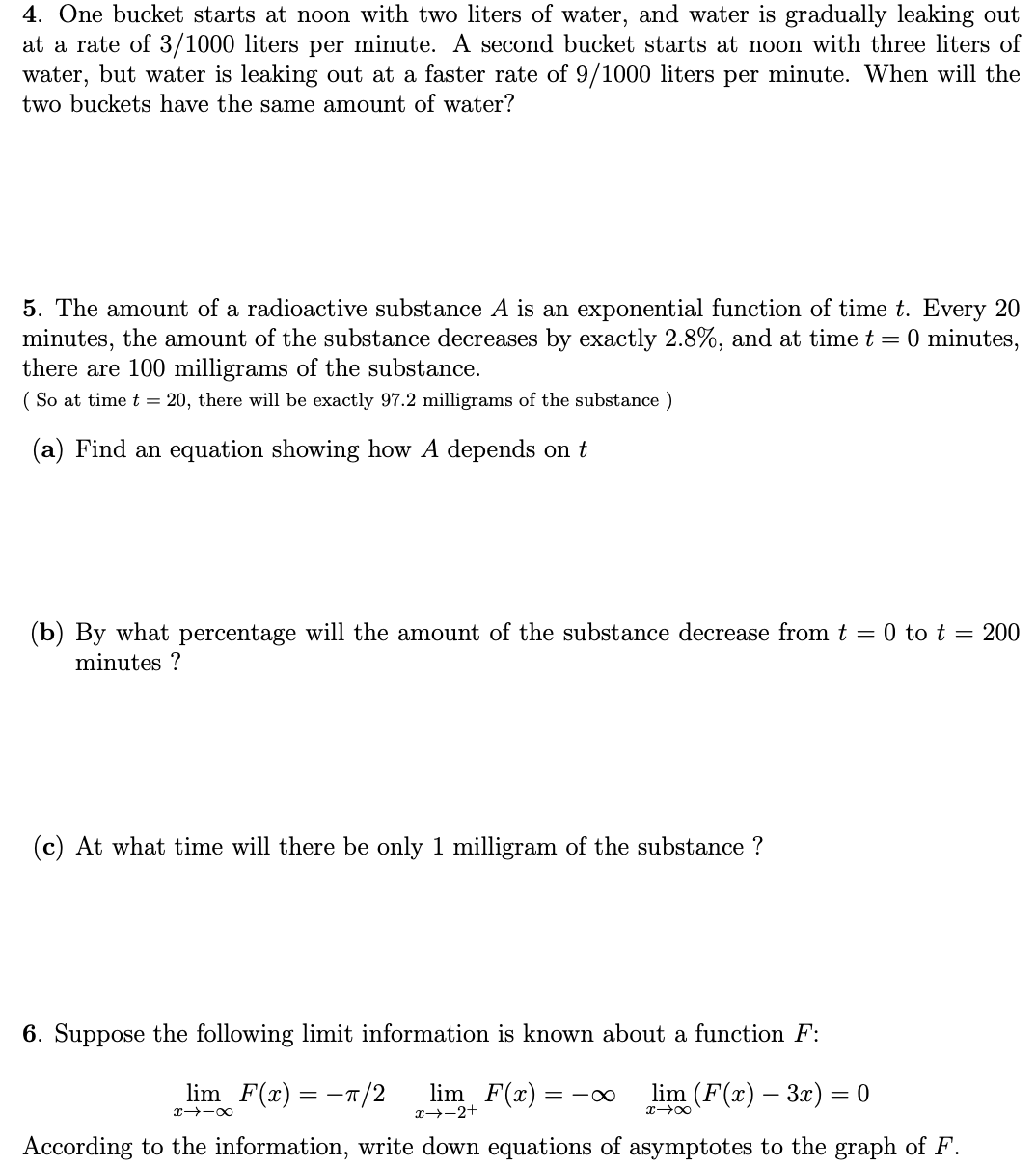4. One bucket starts at noon with two liters of water, and water is gradually leaking out at a rate of 3/1000 liters per minute. A second bucket starts at noon with three liters of water, but water is leaking out at a faster rate of 9/1000 liters per minute. When will the two buckets have the same amount of water?
4. One bucket starts at noon with two liters of water, and water is gradually leaking out at a rate of 3/1000 liters per minute. A second bucket starts at noon with three liters of water, but water is leaking out at a faster rate of 9/1000 liters per minute. When will the two buckets have the same amount of water?
Chapter5: Exponential And Logarithmic Functions
Section5.5: Exponential And Logarithmic Models
Problem 30E: The table shows the mid-year populations (in millions) of five countries in 2015 and the projected...
Related questions
Question
Please, provide all the steps.

Transcribed Image Text:4. One bucket starts at noon with two liters of water, and water is gradually leaking out
at a rate of 3/1000 liters per minute. A second bucket starts at noon with three liters of
water, but water is leaking out at a faster rate of 9/1000 liters per minute. When will the
two buckets have the same amount of water?
5. The amount of a radioactive substance A is an exponential function of time t. Every 20
minutes, the amount of the substance decreases by exactly 2.8%, and at time t = 0 minutes,
there are 100 milligrams of the substance.
( So at time t = 20, there will be exactly 97.2 milligrams of the substance )
(a) Find an equation showing how A depends on t
(b) By what percentage will the amount of the substance decrease from t = 0 to t = 200
minutes ?
(c) At what time will there be only 1 milligram of the substance ?
6. Suppose the following limit information is known about a function F:
lim F(x) = -T/2
lim F(x) :
lim (F(x) – 3x) = 0
= -0
%3D
x -00
x→-2+
x 00
According to the information, write down equations of asymptotes to the graph of F.
Expert Solution
This question has been solved!
Explore an expertly crafted, step-by-step solution for a thorough understanding of key concepts.
Step by step
Solved in 2 steps

Knowledge Booster
Learn more about
Need a deep-dive on the concept behind this application? Look no further. Learn more about this topic, calculus and related others by exploring similar questions and additional content below.Recommended textbooks for you


College Algebra
Algebra
ISBN:
9781305115545
Author:
James Stewart, Lothar Redlin, Saleem Watson
Publisher:
Cengage Learning

Algebra and Trigonometry (MindTap Course List)
Algebra
ISBN:
9781305071742
Author:
James Stewart, Lothar Redlin, Saleem Watson
Publisher:
Cengage Learning


College Algebra
Algebra
ISBN:
9781305115545
Author:
James Stewart, Lothar Redlin, Saleem Watson
Publisher:
Cengage Learning

Algebra and Trigonometry (MindTap Course List)
Algebra
ISBN:
9781305071742
Author:
James Stewart, Lothar Redlin, Saleem Watson
Publisher:
Cengage Learning

Algebra & Trigonometry with Analytic Geometry
Algebra
ISBN:
9781133382119
Author:
Swokowski
Publisher:
Cengage
